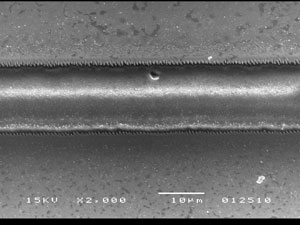A new manufacturing
method using an ultrafast pulsing laser could make thin-film solar cell arrays a
more efficient and less expensive means of power generation.
The current method of connecting solar panels into arrays that
generate usable electricity involves mechanically scribing with a stylus, but this
technique is less than ideal: Not only is it slow and expensive, but it also produces
imperfect channels.
“The efficiency of solar cells depends largely on how accurate
your scribing of microchannels is,” said Yung Shin, a professor of mechanical
engineering and director of Purdue University’s Center for Laser-Based Manufacturing.
“If they are made as accurately as possible, efficiency goes up.”
Shin and his team are working to increase solar cell efficiency
using an ultrashort-pulse laser on thin-film solar cells to produce the microchannels,
he said.
“Production costs of solar cells have been greatly reduced
by making them out of thin films instead of wafers, but it is difficult to create
high-quality microchannels in these thin films,” Shin said. “The mechanical
scribing methods in commercial use do not create high-quality, well-defined channels.

A scanning electron microscope
image shows a microchannel that was created using an ultrafast-pulsing laser. Courtesy
of Purdue University School of Mechanical Engineering. Image/Yung Shin.
“Although laser scribing has been studied extensively, until
now we haven’t been able to precisely control lasers to accurately create
the microchannels to the exacting specifications required.”
The group’s research shows that the ultrafast laser pulses
formed microchannels with sharp boundaries and precisely specified depths. The laser
pulses last only a matter of picoseconds, so the laser does not cause heat damage
to the thin film. It removes material precisely through cold ablation.
“It creates very clean microchannels on the surface of each
layer,” Shin said. “You can do this at very high speed – meters
per second – which is not possible with a mechanical scribe.
“This is very tricky because the laser must be precisely
controlled so that it penetrates only one layer of the thin film at a time, and
the layers are extremely thin. You can do that with this kind of laser because you
have a very precise control of the depth, to about 10 to 20 nanometers.”
Approximately 20 percent of the global photovoltaic market in
terms of watts generated is made up of thin-film solar cells, and experts predict
that this will rise to 31 percent by 2013.
The research is led by Shin and Gary Cheng, an associate professor
of industrial engineering. The work is funded through a three-year, $425,000 grant
from the National Science Foundation.
A paper demonstrating the method’s feasibility was published
in Proceedings of the 2011 NSF Engineering Research and Innovation Conference. The
paper was written by Shin, Cheng andgraduate students Wenqian Hu, Martin Yi Zhang
and Seunghyun Lee.